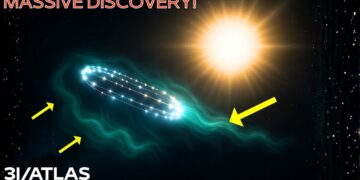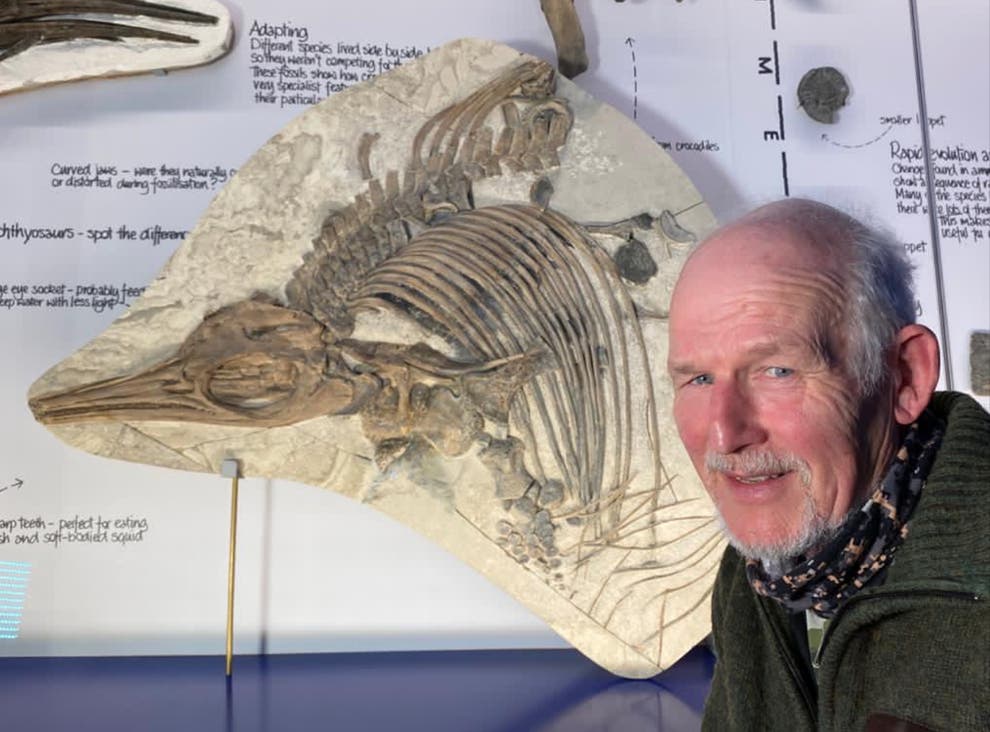When Threeey Atlas was first detected, it appeared as a faint glimmer against the vast emptiness of space—a quiet white reflection on the edge of nothingness. It moved slowly, predictably, like any comet. But no one could have foreseen how quickly this faint white object would transform into the most unsettling mystery of our time. Months later, it no longer resembles anything natural. The white glow has faded, the yellow haze that followed burned away, and the emerald green that captivated astronomers all summer has vanished. In its place is something deeply disturbing: a blood-red radiance pulsing from within, like an active reactor. This isn’t the red of Martian dust—it’s the red of plasma, infused with something burning from within.
When astronomers first scanned Threeey Atlas in infrared, it was emitting nearly 10 gigawatts of heat—already 100 times the power of Chernobyl. Now, readings show it has surged past 50 gigawatts. That kind of energy output is impossible for a natural comet. It’s no longer reflecting sunlight; it’s generating it, as if something inside has awakened. No one can explain it. Yet, a few scientists, most notably Harvard astrophysicist A. Lobe, suggest the explanation might be right in front of us.
Lobe, who has tracked Threeey Atlas from the start, says its transformation began subtly when it entered the inner solar system. Initially, it was bright white, with ordinary sunlight scattering off dust and frozen ice. As it approached the sun, it developed a faint yellow tail, signaling sublimation—the melting of ice directly into gas. But what followed was inexplicable. Almost overnight, Threeey Atlas ignited into a luminous emerald halo, so bright it illuminated telescopes from Namibia to Chile. Scientists initially assumed it was diatomic carbon fluorescence, a chemical reaction triggered by ultraviolet sunlight. But spectroscopic data revealed something impossible: there were no carbon chain molecules. In other words, it wasn’t supposed to glow green. No known natural process could explain it.
Now, without warning, the green has vanished, replaced by a red hue so deep and sharp that instruments detect temperatures 5,000°C higher than anything natural at that distance from the sun. In simple terms, the object is generating its own heat. According to Lobe, the color sequence isn’t random—it’s functional, a calculated pattern, a “timeline of power.” He compares it to an engine waking up, one phase at a time. White, he says, was the dormant stage, reflecting sunlight off a frozen shell, a body conserving energy. Yellow marked absorption, when it began drawing in solar radiation, storing it like a battery charging in the dark. Green was activation, when the object stopped being passive, its chemistry changed, and its emissions spiked, producing light not from the sun. Now, the red—the most intense and final stage—signals full power, the ignition of something deep inside. If true, Threeey Atlas isn’t just heating up; it’s powering on.
But if Threeey Atlas is burning from within, what’s fueling it? Over the past few months, observatories have analyzed gas signatures from its coma—the cloud of material surrounding its core. The findings are baffling: the coma contains nickel vapor mixed with carbon dioxide and metallic particles. This isn’t comet chemistry. Nickel only vaporizes at temperatures near 3,000°C, roughly the surface temperature of a small star—impossible unless it’s dangerously close to the sun. Yet Threeey Atlas is still in the cold region near Mars. Nothing in its environment should heat it that much, so the heat must come from within the object itself.
Even stranger, nickel, carbon dioxide, and infrared radiation match the signature of an engineered plasma propulsion system. Nickel is used in high-temperature alloys for spacecraft engines, which release trace amounts of nickel and CO2 as byproducts when fired. In other words, what astronomers are detecting resembles exhaust, not sublimation. The timing of the red glow aligns perfectly: as Threeey Atlas passed Mars, the gravitational environment changed dramatically. To maintain a controlled course, an artificial probe would need to increase thrust and energy output, naturally shifting its emission spectrum toward red. Could this be what we’re seeing—not a comet reacting to sunlight, but a machine adjusting its thrust, switching modes like an engine changing gears?
Another puzzling detail is its mass. Comets typically lose material as they approach the sun, their ice melting, cores shrinking, and shedding weight as dust trails. But Threeey Atlas is doing the opposite. The more it travels, the heavier it gets, with estimates rising from 10 billion tons at discovery to over 33 billion tons now. This shouldn’t be possible unless it’s actively collecting matter. This suggests it’s feeding. If Threeey Atlas is an alien probe, the red glow might be plasma energy, burning interplanetary dust or gas as fuel, harvesting matter as it moves. Its increasing mass could be part of this process, converting particles into usable energy. Some physicists speculate an advanced civilization could design a craft to recharge this way, using ambient dust and radiation as fuel, never running out of power.
The most haunting clue is its trajectory. Every recorded comet wobbles as it moves, with gas jets acting like unpredictable thrusters, pushing them slightly off course. ‘Oumuamua, the first known interstellar visitor, veered wildly; 2I/Borisov shifted over 100 kilometers daily. But Threeey Atlas is unnaturally stable, deviating by less than a kilometer per day since discovery. It moves in a straight, steady line, as if guided. No natural comet behaves this way.
For Lobe and other open-minded astrophysicists, this is the real giveaway. A steady trajectory, changing emission colors, metallic gas signatures, and growing mass don’t describe a natural object—they describe something controlled, alive, or automated. However, not everyone agrees. Neil deGrasse Tyson and Michio Kaku offer conventional explanations, though even they seem unconvinced. Tyson suggests the red shift could result from deeper comet layers being exposed as outer ice burns away, revealing iron-rich compounds that glow crimson in sunlight. Kaku argues that complex chemical reactions occur as comets pass through varying solar system regions, each affecting their composition differently. But both admit the data doesn’t fit: the soaring nickel levels, overwhelming carbon dioxide, and absence of carbon chain molecules are not just unusual—they’re impossible under natural conditions. Even Tyson, ever the skeptic, recently admitted, “It’s behaving like something that doesn’t want to be a comet.”
Even if Threeey Atlas were the strangest comet ever, it shouldn’t be this stable, heavy, or deliberate in its transformation. Every time scientists find a natural explanation, two more inconsistencies arise. Lobe says the ultimate test is coming. In the next few days, Threeey Atlas will approach Jupiter, the solar system’s largest gravitational force besides the sun. If it’s a machine, this will be its greatest challenge. To survive Jupiter’s gravity, it would need to adjust its thrust again. If Lobe is right, the color will shift—perhaps to blue or brighter white, signaling another power phase to stabilize against Jupiter’s pull. If the glow remains unchanged, it may already be at full power. Either way, the coming weeks will reveal whether this object is flying blind or with intent.
So, what do you think? Are we witnessing the awakening of a machine drifting through space for centuries, or just the strangest comet in history, defying every known law? Let me know in the comments below. If you want to follow what happens next, like, subscribe, and turn on notifications—because whatever this is, the story isn’t over.























